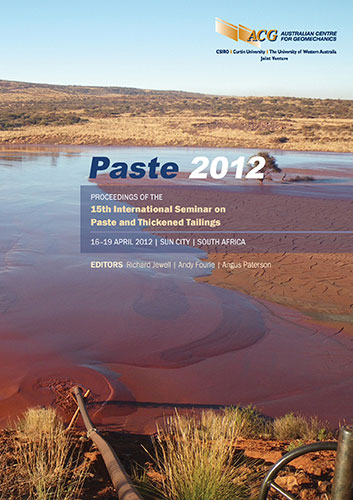Flocculant testing through the application of experimental design techniques and the application of a flocculant pipe reactor

|
Authors: Cooks, M; Plaatjies, B |
DOI https://doi.org/10.36487/ACG_rep/1263_15_Cooks
Cite As:
Cooks, M & Plaatjies, B 2012, 'Flocculant testing through the application of experimental design techniques and the application of a flocculant pipe reactor', in R Jewell, AB Fourie & A Paterson (eds), Paste 2012: Proceedings of the 15th International Seminar on Paste and Thickened Tailings, Australian Centre for Geomechanics, Perth, pp. 169-181, https://doi.org/10.36487/ACG_rep/1263_15_Cooks
Abstract:
This work presents the experience with the application of a flocculent pipe reactor for flocculant evaluation and selection at Langer Heinrich Mine. Other processes could give different results. Parameters considered in determining the conditions that generate the optimum solids settling rate and overflow clarity are: slurry density, reaction time, turbulent shear rate (slurry flow rate), flocculent make-up concentration, flocculant dosing rate and type of flocculant. Two polyacrylamide flocculants used in the process were tested: Alclar 665 and Magna 333. The data was generated and processed in accordance with the response surface methodology. This methodology renders a mathematical model from which the optimum for each parameter in combination with the other parameters can be determined. The distinctive feature of this method of conducting settling tests is the ability to verify the interaction between parameters and higher order effects of parameters.
References:
Atesok, G., Somasundaran, P. and Morgan, L.J. (1988) Charge effects in the adsorption of polyacrylamides on sodium kaolinite and its flocculation, Powder Technology, Elsevier, Vol. 54, pp. 77–83.
Bradley, N. (2007) The response surface methodology, Master of Science in Applied Mathematics and Computer Science, Y. Cheng (ed), Indiana University South Bend, 84 p.
Carley, K.M., Natalia, Y.K. and Reminga, J. (2004) Response surface methodology, CMU-ISRI-04-136, CASOS technical report, Carnegie Mellon University, 31 p.
Carissimi, E. and Rubio, J. (2005) The flocs generator reactor-FGR: a new basis for flocculation and solid-liquid separation, International Journal of Mineral processing, Science Direct, Vol. 75, pp. 237–247.
Concha, F. and Burger, R. (2003) Thickening in the 20th century: a historical perspective, Minerals and Metallurgical Processing, Society of Mining, Metallurgy, and Exploration, Inc., 20 May 2003, pp. 57–67.
Heath, A.R. and Koh, P.T.L. (2003) Combined population balance and CFD modelling of particle aggregation by polymeric flocculant, in Proceedings Third International Conference on CFD in the Minerals and Process Industries, December 2003, Melbourne, Australia, CSIRO, pp. 339–344.
Ntshabele, K., Cooks, M., Busani, B. and Dodo, J. (2008) The Effect of Water Quality on Dewatering Properties of Debswana Kimberlitic Ores, in Proceedings 11th International Seminar on Paste and Thickened Tailings (Paste08), A.B. Fourie,
R.J. Jewell, P. Slatter and A. Paterson (eds), 5–9 May 2008, Kasane, Botswana, Australian Centre for Geomechanics, Perth, pp. 113–124.
Owen, A.T., Fawell, P.D., Swift, J.D., Labbett, D.M., Benn, F.A. and Farrow, J.B. (2008) Using turbulent pipe flow to study the factors affecting polymer-bridging flocculation of mineral systems, Elsevier, 87, pp. 90–99.
Rigas, F., Panteleos, P. and Laoudis, C. (2000) Central composite design in a refinery’s wastewater treatment by air flotation, Global nest: the international journal, Global Nest, Vol. 2, No. 3, pp. 245–253.
Weir, S. and Moody, G.M. (2003) The importance of flocculant choice with consideration to mixing energy to achieve efficient solid/liquid separation, Minerals Engineering, Elsevier, Vol. 16, No 2.
© Copyright 2025, Australian Centre for Geomechanics (ACG), The University of Western Australia. All rights reserved.
View copyright/legal information
Please direct any queries or error reports to repository-acg@uwa.edu.au
View copyright/legal information
Please direct any queries or error reports to repository-acg@uwa.edu.au